Einride launches next-gen autonomous electric transport vehicle
Sweden’s Einride, a freight mobility company, recently launched its groundbreaking Pod, a fully autonomous electric transport vehicle.
In 2019, Einride became the first company in the world to drive a fully autonomous and electric heavy transport vehicle on a public road and has been testing and operating Pods at select customer sites in Sweden over the past year.
Now, businesses around the world can reserve the technology and start shipping sustainably and cost-competitively with Autonomous Electric Transport (AET) coordinated by the intelligent freight mobility platform.
“We started this journey in 2016 with a dream to build a better future through technology. Years of hard work and dedication from the whole team at Einride have made us the leader in AET, and today we are taking the next step to bring our solutions to the world and ramp up the transition to a more sustainable future of transport,” said Robert Falck, CEO and founder of Einride.
The new Pod features a refined design, making it more aerodynamic and functional but also preparing it for wide-scale production and commercialization. For the first time, the Pod is available for reservation for those looking to transition away from analog, inefficient diesel transport solutions to a freight mobility solution that is safer, more sustainable, and more cost-effective, according to the company.
“The Pod is a completely novel vehicle, and therefore doesn’t fit into existing standards, even for cutting-edge technologies like autonomy. We created the AET classification system based on use cases for a driverless, electric freight vehicle. With this approach, we are able to develop and scale our capabilities in the most common and appropriate use cases for freight, with the ultimate goal of automating as much of the transport network as possible,” said Pär Degerman, CTO of Einride.
The AET classification system ranges from levels 1 to 5, and levels 1 to 4 are available for pre-order based on individual business needs. AET 1 (Fenced) is ideal for closed facilities with predetermined routes that are best suited for fully autonomous operation. AET 2 (Nearby) includes closed facility operation but adds the capability to traverse public roads over short distances between destinations. Both AET 1 and 2 Pods are available for reservation now and will begin shipping to customers starting next year.
AET 3 (Rural) takes the Pod’s functionality to the next level, allowing operation on backroads and less busy main roads between facilities, at a maximum operating speed of 45 km/h. Finally, AET 4 (Highway) includes fully autonomous operation on freeways and other major roads at up to 85 km/h. Levels 3 and 4 are available for pre-order and will ship to customers in 2022-2023.
Two leaders in the autonomous trucking sector, TuSimple and Waymo, spoke about the possibilities for autonomous trucking in the future at a TechCrunch event in early October.
Boris Sofman of Waymo talked about the autonomous trucking market.
“The market is massive; I think in the United States, $700-$800 billion a year is spent on the trucking industry. It’s continuing to grow every single year,” said Sofman. “And there’s a huge shortage of drivers today, which is only going to increase over the next period of time. It’s just such a clear need. But it’s not going to be overnight — there’s still a really long tail of challenges that you can’t avoid. So, the way we talk about it is the things that are hardest are just different.”
TuSimple founder Xiaodi Hou talked about the economics of autonomous trucking.
“It’s really the cost and reward analysis, thinking about building the operating system,” said Hou. “The cost is the number of features that you develop, and the reward is basically how many miles are you driving — you charge on a per mile basis. From that cost-reward analysis, trucking is simply the natural way to go for us. The total number of issues that you need to solve is probably 10 times less, but maybe, you know, five times harder. It’s really hard to quantify those numbers, though,” he concluded, “but you get my point.”






